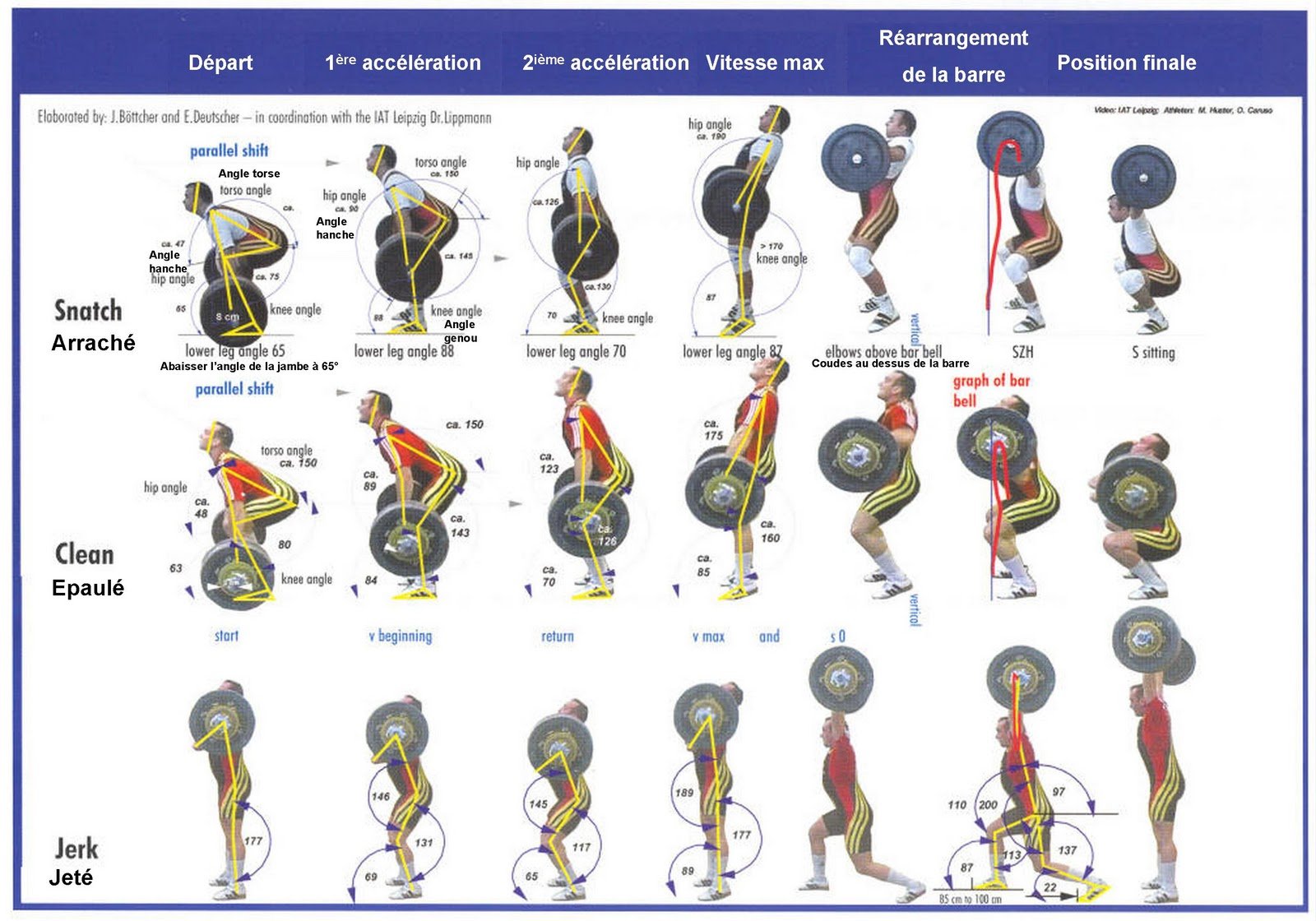Are you a beginner looking to build strength for MMA? Look no further! In this article, we will share the top ways for MMA beginners to enhance their strength. Whether you’re new to MMA or just starting out, these tips will help you develop the physical power needed to excel in the sport. From weightlifting exercises to functional movements, we’ve got you covered. Get ready to take your MMA journey to the next level!
Strength Training Exercises
Whether you’re a beginner or an experienced MMA fighter, incorporating strength training exercises into your workout routine is essential for improving your overall performance. Strength training not only enhances your power, speed, and endurance but also helps prevent injuries. Here are some highly effective strength training exercises you can incorporate into your regimen.
Compound Movements
Compound movements are exercises that engage multiple muscle groups and joints simultaneously. These exercises target the major muscle groups and are efficient for building overall strength and functional movements. Examples of compound movements include squats, deadlifts, bench presses, and overhead presses. By incorporating compound movements into your routine, you’ll not only build strength but also improve your coordination and stability.
Bodyweight Exercises
Bodyweight exercises are an excellent way to build strength without the need for heavy gym equipment. These exercises use your own body weight as resistance and can be done anywhere, making them perfect for a home workout or when you’re traveling. Bodyweight exercises like push-ups, squats, lunges, and planks not only build strength but also improve your balance, flexibility, and stability.
Weightlifting Techniques
Weightlifting techniques, such as clean and jerk, snatch, and power cleans, are crucial for improving explosive power and strength. These exercises involve lifting heavy weights in a controlled manner, which challenges your muscles and forces them to adapt and grow stronger. Weightlifting techniques also engage your core, improving stability and balance. It’s essential to learn proper form and technique from a qualified instructor to prevent injuries and maximize the benefits of weightlifting.
Resistance Training
Resistance training involves using external resistance, such as dumbbells, resistance bands, or weight machines, to challenge your muscles and promote strength gains. Resistance training exercises can target specific muscle groups or be full-body movements. Examples of resistance training exercises include bicep curls, tricep dips, lateral raises, and leg presses. By progressively increasing the resistance, you can continuously challenge your muscles and stimulate growth.
Cardiovascular Conditioning
To excel in MMA, you not only need strength but also cardiovascular endurance. Cardiovascular conditioning exercises elevate your heart rate, improve your stamina, and increase your overall fitness level. Here are some effective cardio exercises to incorporate into your training routine.
Running and Jogging
Running and jogging are classic cardiovascular exercises that require minimal equipment. These exercises help improve your endurance, lung capacity, and cardiovascular health. Whether you prefer outdoor running or treadmill jogging, gradually increasing your distance and speed will help you build stamina and improve your overall fitness.
Cycling
Cycling is another low-impact cardiovascular exercise that not only improves cardiovascular fitness but also strengthens your leg muscles. Whether you choose to ride a stationary bike or hit the road, cycling is an excellent way to build endurance and burn calories. It also allows for interval training, which can further enhance your cardiovascular conditioning.
Skipping
Skipping or jump rope exercises are a fun and effective way to improve cardiovascular endurance. Skipping engages your entire body and helps improve coordination, agility, and footwork. It can be done at any intensity, making it suitable for beginners and advanced athletes alike. Incorporating different skipping techniques, such as double-unders or high knees, can add variety and challenge to your workouts.
HIIT Workouts
High-Intensity Interval Training (HIIT) workouts involve short bursts of intense exercises followed by periods of rest or low-intensity exercises. HIIT workouts are time-efficient and effective for improving cardiovascular conditioning. These workouts can include a variety of exercises such as burpees, mountain climbers, jumping jacks, and high knees. HIIT helps improve both aerobic and anaerobic fitness, making it a valuable addition to your training routine.
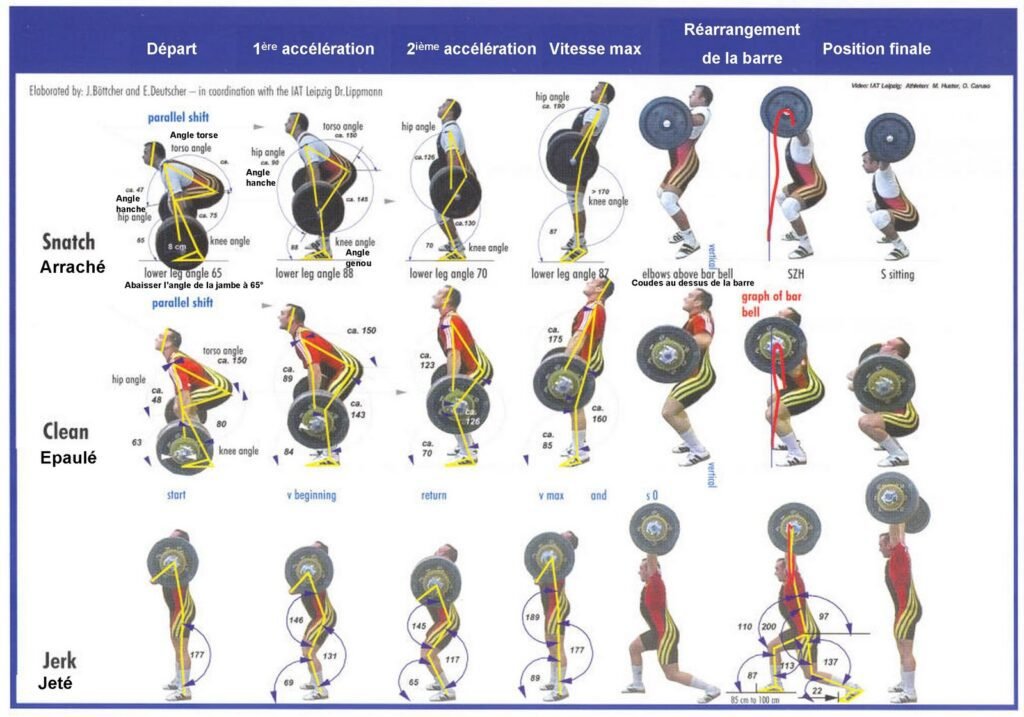
Core Strengthening
A strong and stable core is crucial for generating power and transferring energy efficiently in MMA. Core strengthening exercises not only improve your punching and kicking power but also enhance your balance and stability. Here are some effective core strengthening exercises to incorporate into your training routine.
Plank Variations
Plank variations, such as standard planks, side planks, and plank walks, are fantastic exercises for targeting your core muscles. Planks engage your abdominal, oblique, and lower back muscles, promoting overall core strength and stability. Start with shorter hold times and gradually increase the duration as your core strength improves.
Russian Twists
Russian twists target your oblique muscles, which are essential for rotational movements in MMA. Sit on the floor with your knees bent, lean back slightly, and lift your feet off the ground. Hold a weight or medicine ball, and twist your torso from side to side, touching the weight to the ground on each side. Russian twists improve core stability and rotational power.
Hanging Leg Raises
Hanging leg raises primarily target your lower abdominal muscles and hip flexors. Hang from a pull-up bar with your arms extended, and lift your legs straight out in front of you until they’re parallel to the ground. Lower them back down with control. Hanging leg raises are challenging but effective for building core strength and stability.
Medicine Ball Exercises
Medicine balls are versatile tools for core strengthening exercises. Exercises like medicine ball slams, rotational throws, and Russian twists with a medicine ball engage your core muscles while adding resistance. Incorporating medicine ball exercises into your routine can help improve your core strength, stability, and explosive power.
Flexibility Training
Flexibility is often overlooked but is a vital component of MMA training. Being flexible not only reduces the risk of injuries but also allows for a wider range of motion, improving your technique and overall performance. Here are some flexibility training exercises to incorporate into your routine.
Static Stretches
Static stretches involve holding a stretch for a prolonged period, allowing your muscles to relax and lengthen. Performing static stretches after a workout or during rest days helps improve flexibility and range of motion. Key static stretches for MMA include hamstring stretches, groin stretches, calf stretches, and shoulder stretches. Remember to warm up your muscles before performing static stretches to prevent injury.
Dynamic Stretches
Dynamic stretches involve moving your muscles and joints through a full range of motion, mimicking the movements you’ll perform during your MMA training. Dynamic stretches help improve flexibility, increase blood flow to the muscles, and prepare your body for physical activity. Examples of dynamic stretches for MMA include arm circles, leg swings, walking lunges, and trunk rotations.
Yoga
Yoga not only improves flexibility but also promotes mental focus and relaxation. It combines stretching, strength building, and balance exercises, making it an ideal addition to your MMA training. Yoga poses such as downward dog, warrior poses, pigeon pose, and standing splits target various muscle groups and encourage flexibility and stability.
Foam Rolling
Foam rolling, also known as self-myofascial release, involves using a foam roller to apply pressure to specific muscles to relieve tension and tightness. Foam rolling helps improve flexibility, increase blood flow, and reduce muscle soreness. Spend time foam rolling your major muscle groups, such as your calves, quads, glutes, and back, to improve mobility and aid in recovery.
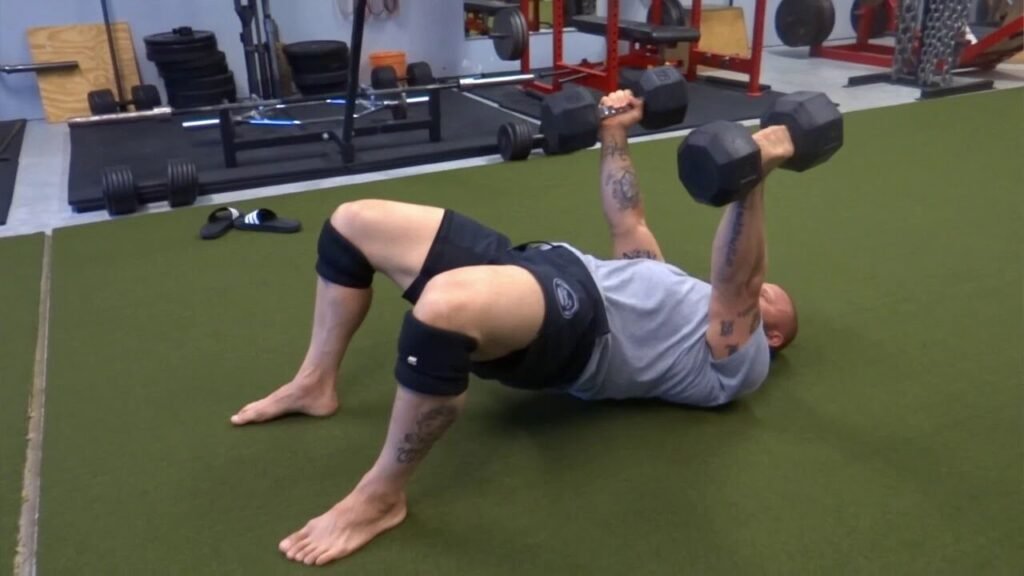
Explosive Power Training
Explosive power is crucial for delivering powerful strikes, explosive takedowns, and fast movements in MMA. Incorporating explosive power training exercises into your routine will help you develop speed, coordination, and explosiveness. Here are some explosive power training exercises to incorporate into your regimen.
Plyometric Exercises
Plyometric exercises involve explosive movements that improve your ability to generate power quickly. They require rapid muscle contractions and help train your muscles to become more efficient and explosive. Examples of plyometric exercises include jump squats, clap push-ups, box jumps, and plyometric lunges. Begin with proper form and gradually increase the intensity and height of your jumps as your explosive power improves.
Box Jumps
Box jumps are a popular plyometric exercise that targets your leg and core muscles while building explosive power. Find a sturdy box or platform and jump onto it from a standing position, landing softly with both feet. Step down from the box or jump back down and repeat the movement. Box jumps can be modified to suit your fitness level by adjusting the height of the box.
Medicine Ball Throws
Medicine ball throws mimic movements you’ll encounter in MMA, such as throwing punches or explosive takedowns. Stand facing a wall or partner with a medicine ball in hand, and explosively throw the ball towards the target. Catch or retrieve the ball and repeat. Medicine ball throws are effective for developing upper body explosiveness and rotational power.
Sled Pushes
Sled pushes are a full-body exercise that targets your leg and core muscles while improving explosive strength. Load a sled with weight plates, position yourself in front of it, and push it forward using your lower body and core. The resistance provided by the sled challenges your muscles and helps develop explosive power. Gradually increase the weight to continuously challenge and improve your explosiveness.
Grip Strength Development
Grip strength is often overlooked but is a crucial aspect of MMA training. A strong grip is essential for grappling, clinching, and controlling your opponent. Here are some grip strength development exercises to incorporate into your routine.
Grip Strengthening Exercises
Grip strengthening exercises involve using grip trainers, hand grippers, or towel hangs to improve the strength and endurance of your forearms, hands, and fingers. Squeeze a grip trainer or hand gripper for several repetitions, or hang from a towel or bar for time. These exercises will help develop the crushing power and endurance of your grip.
Deadlifts
Deadlifts are a compound exercise that targets several muscle groups, including your grip and forearm muscles. By lifting heavy weights off the ground, you challenge your grip strength and force your muscles to adapt and grow stronger. Start with proper form and gradually increase the weight as your grip strength improves.
Farmer’s Walk
The farmer’s walk exercise involves walking while holding heavy weights in each hand. This exercise places a significant demand on your grip strength and requires you to maintain stability and control. Hold dumbbells or kettlebells with a firm grip and walk for a certain distance or time. The farmer’s walk is a functional exercise that not only strengthens your grip but also improves your core stability and posture.
Kettlebell Swings
Kettlebell swings are a full-body exercise that engages your grip, core, and lower body muscles. Hold a kettlebell with both hands, hinge at the hip, and swing the kettlebell between your legs before explosively driving your hips forward and swinging the kettlebell to shoulder height. Kettlebell swings challenge your grip strength and reinforce proper hip hinge and explosiveness.
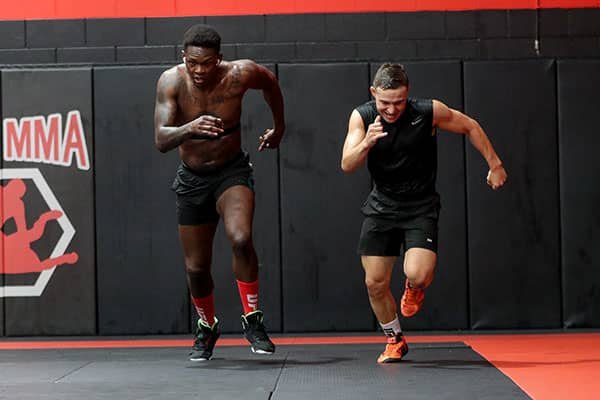
Balance and Stability Training
Good balance and stability are essential for maintaining control, preventing injuries, and executing precise movements in MMA. Incorporating balance and stability training exercises into your regimen will help improve your body control and overall performance. Here are some exercises to enhance your balance and stability.
Bosu Ball Exercises
Bosu balls are versatile tools that challenge your balance and stability. Standing on a Bosu ball engages the small stabilizing muscles in your feet, ankles, and legs, while performing exercises like squats, lunges, and single-leg movements. Start with basic exercises and gradually progress to more challenging movements as your balance and stability improve.
Single-Leg Exercises
Single-leg exercises are an excellent way to improve balance, stability, and leg strength. Examples include single-leg squats, lunges, Romanian deadlifts, and pistol squats. By performing these exercises while balancing on one leg, you engage your core and lower body muscles while enhancing your body control and stability. Start with assistance if needed and gradually progress to unassisted movements as your balance improves.
Balance Boards
Balance boards are specifically designed to challenge your balance and stability. They consist of a board placed on a rounded base, and by standing or performing exercises on the board, you engage your stabilizing muscles and improve your body control. Start with basic exercises such as standing on the balance board and gradually progress to more advanced movements such as squats or push-ups.
Agility Ladder Drills
Agility ladder drills are excellent for improving footwork, coordination, and agility. Set up an agility ladder on the ground and perform various movements, such as lateral shuffles, high knees, or quick feet drills. Agility ladder drills challenge your balance and stability while enhancing your ability to change directions quickly, an essential skill in MMA.
Circuit Training
Circuit training involves performing a series of exercises targeting different muscle groups or movement patterns with little to no rest in between. It is an effective way to improve cardiovascular fitness, build strength, and enhance muscular endurance. Here’s how to structure a circuit training workout.
Full-Body Workouts
Design your circuit to include exercises that target different muscle groups. For example, you can include exercises like push-ups, squats, rows, lunges, and planks. This approach ensures that you’re working your entire body and maximizing your workout’s efficiency. Aim for a balance between strength exercises and cardio-based exercises to get the best results.
Interval Training
Incorporate interval training into your circuit by including exercises that elevate your heart rate. For example, you can intersperse bodyweight exercises like burpees, mountain climbers, or jumping jacks with strength exercises. This combination challenges your cardiovascular system while promoting strength gains.
Functional Movements
Include functional movements in your circuit training, as they mimic the movements you’ll perform in MMA. Exercises like kettlebell swings, medicine ball slams, battle rope exercises, or sled pushes engage multiple muscle groups and help improve overall strength, power, and endurance.
Incorporating MMA Techniques
To make your circuit training more sport-specific, incorporate MMA techniques into your routine. For example, you can include punching combinations, sprawls, takedowns, or ground and pound movements. By focusing on these techniques during your circuit, you’ll improve your muscle memory and conditioning for MMA-specific movements.
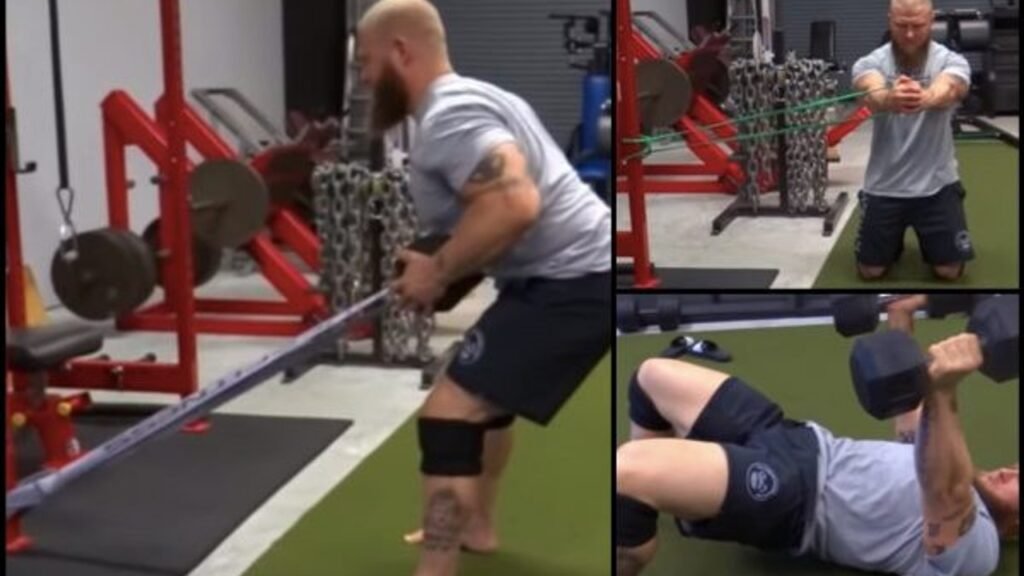
Proper Nutrition
Proper nutrition plays a crucial role in building strength and fueling your body for optimal performance. Here are some key nutrition considerations for MMA beginners.
Adequate Protein Intake
Protein is essential for muscle repair and growth. Incorporate lean protein sources such as chicken, turkey, fish, eggs, tofu, or Greek yogurt into your diet. Aim for a protein intake of around 0.8 to 1.2 grams per pound of body weight to support muscle recovery and development.
Balanced Diet
A balanced diet that includes a variety of fruits, vegetables, whole grains, and healthy fats is crucial for overall health and performance. Incorporate foods rich in vitamins, minerals, and antioxidants into your meals to support your immune system and aid in recovery.
Hydration
Staying hydrated is vital for maintaining optimal performance and preventing dehydration. Drink water throughout the day and ensure you’re adequately hydrated before, during, and after training sessions. Monitor your urine color as a general guide to your hydration status – it should be pale yellow.
Pre- and Post-Workout Meals
Fueling your body before and after workouts is important for muscle recovery and energy replenishment. Before workouts, have a balanced meal that includes carbohydrates for energy, protein for muscle repair, and small amounts of healthy fat for sustained energy. After workouts, consume a protein-rich meal or snack within 30 minutes to support muscle recovery and growth.
Rest and Recovery
Rest and recovery are often overlooked but are essential for muscle repair and growth. Here are some key strategies for optimizing your rest and recovery.
Quality Sleep
Sleep is crucial for your body to repair and regenerate. Aim for 7-9 hours of quality sleep each night to support muscle recovery and overall well-being. Create a conducive sleep environment by keeping your bedroom dark, quiet, and cool.
Active Recovery Days
Incorporate active recovery into your training routine by engaging in low-intensity activities such as walking, swimming, or practicing yoga. Active recovery promotes blood flow and helps flush out metabolic waste, reducing muscle soreness and aiding in recovery.
Massage Therapy
Consider incorporating regular massage therapy into your routine to promote muscle recovery, reduce muscle tension, and improve flexibility. Massage therapy can help alleviate muscle soreness and speed up the recovery process.
Foam Rolling
Foam rolling, as mentioned earlier, can help release tension in your muscles and improve mobility. Perform foam rolling exercises on your major muscle groups regularly to enhance your recovery and prevent muscle imbalances.
By incorporating these strength training exercises, cardiovascular conditioning workouts, core strengthening exercises, flexibility training, explosive power training, grip strength development, balance and stability training, circuit training, proper nutrition, and rest and recovery strategies into your training routine, you’ll be well on your way to building strength for MMA. Remember to start gradually, listen to your body, and seek guidance from a qualified trainer or coach. Good luck on your journey to becoming a stronger MMA athlete!


